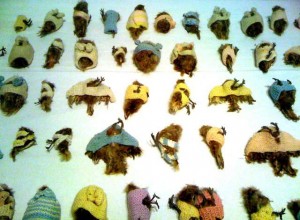Ritual Repetition, Mourning: Part 1
In The Boarders’ Repose, Annette Messager clothes dead birds with tiny sweaters. Each creature’s sweater is different, each delicately made, each warming a tiny cold dead bird body. Some of the sweaters are vests. Rows upon rows of dead birds, the boarders’ repose.
The vests would allow the birds a full range of wing use if they were to come back to life and desired to fly. Other sweaters bind bird’s wings to their breasts, making flight in the afterlife impossible. Those birds are out of luck. There are also birds that wear delicate shawls, in all the pastel colors we use for newborn babies: light blue, pink, yellow, and cream. All of these sweaters warm the still chests of these birds: enclosing, capturing, holding, mummifying. Messager clothes the birds, that are already wearing their feathers, and then places the birds in a glass tomb. In this poetic contemplation on death, Messager’s birds are presented neatly preserved. We imagine her holding each bird body, looking it over, and setting it down tenderly. Messager’s process is closer to mummification or embalming than taxidermy: the birds are dressed in finery created through an elaborate process of knitting.
Messager treats each of these 72 bodies as specific, knitting each bird a unique sweater. Her use of a personal, domestic action to mourn for an overwhelming number of bodies emphasizes the need to bring attention to these deaths as a group, as well as individually. Therefore, The Boarders Repose is a quiet contemplation on death with strong political undertones.
As Judith Butler argued in a recent lecture, when groups of beings are not deemed grievable, violence against these people or animals or environments is no longer recognized as violence, and thus starts to be perceived as acceptable. There are numerous examples of this phenomenon within our collective human history and in our contemporary moment. The Boarders’ Repose, in its particular attention to the individual within an entire group of lost lives, is more clearly understood through the lens of mourning as it relates to justice.
By making each life visible, Messager conveys the massive scale of these deaths. When specific lives are mourned, we understand that specific bodies feel or felt pain. We relate. As Levinas wrote, this relationship to another body and another life causes us to realize our responsibility to the Other. We, as viewers, become responsible. From this position, violence against specific, visible individuals becomes a question of justice.
These bodies belong to birds who were once wild creatures; animals whom our society widely considers expendable, and whose deaths we don’t usually mourn. Messager’s actions call out and affirm the worth and value of these lives. Her work of mourning is not quick, simple, or easily forgotten. The labor of knitting unique sweaters is a conscious, slow, deliberate, and individual mourning.




Dilettante Mail
Get updates from us a few times a year.